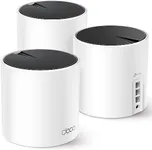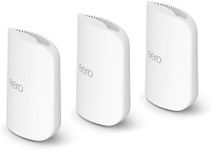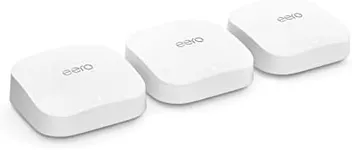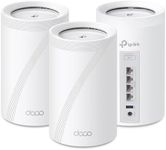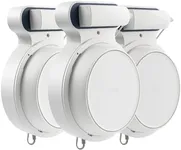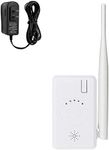Buying Guide for the Best Mesh Wifi Systems
Mesh Wi-Fi systems are designed to provide seamless and reliable internet coverage throughout your home or office. Unlike traditional routers, mesh systems use multiple nodes to create a unified network, ensuring that you have strong Wi-Fi signals in every corner of your space. When choosing a mesh Wi-Fi system, it's important to consider several key specifications to ensure you get the best performance and coverage for your needs.Coverage AreaCoverage area refers to the total space that the mesh Wi-Fi system can effectively cover. This is important because it determines how well the system will work in your home or office. Coverage is usually measured in square feet. Smaller homes or apartments may only need coverage up to 2,000 square feet, while larger homes or offices may require coverage of 4,000 square feet or more. To pick the right coverage area, consider the size of your space and any potential obstacles like walls or floors that could interfere with the signal.
Number of NodesNodes are individual units that make up the mesh Wi-Fi system. The number of nodes you need depends on the size and layout of your space. A small apartment might only need one or two nodes, while a larger home with multiple floors might require three or more. More nodes generally mean better coverage and stronger signals, but it's important to balance the number of nodes with your actual needs to avoid unnecessary expense.
SpeedSpeed refers to the maximum data transfer rate that the mesh Wi-Fi system can handle, usually measured in megabits per second (Mbps). This is crucial for activities like streaming, gaming, and video conferencing. Basic systems may offer speeds up to 300 Mbps, which is sufficient for general browsing and streaming. For more demanding tasks, look for systems that offer speeds of 600 Mbps or higher. Choose a speed that matches your internet plan and usage habits to ensure smooth performance.
Band SupportMesh Wi-Fi systems can operate on different frequency bands, typically 2.4 GHz and 5 GHz. Dual-band systems support both frequencies, while tri-band systems add an additional 5 GHz band for better performance. The 2.4 GHz band offers longer range but slower speeds, while the 5 GHz band provides faster speeds but shorter range. Tri-band systems are ideal for high-traffic networks with multiple devices. Consider your usage and the number of devices connected to your network when choosing band support.
Ease of SetupEase of setup refers to how simple it is to install and configure the mesh Wi-Fi system. Some systems come with user-friendly apps that guide you through the setup process, while others may require more technical knowledge. If you're not tech-savvy, look for systems that offer straightforward, app-based setup. This will save you time and frustration, ensuring that you can get your network up and running quickly.
Security FeaturesSecurity features are essential for protecting your network from unauthorized access and cyber threats. Look for mesh Wi-Fi systems that offer robust security protocols like WPA3 encryption, automatic firmware updates, and parental controls. These features help keep your data safe and allow you to manage access for different users. Choose a system with strong security features to ensure peace of mind and protect your personal information.
CompatibilityCompatibility refers to how well the mesh Wi-Fi system works with your existing devices and internet service provider. Some systems are designed to work seamlessly with specific ISPs or smart home devices. Check the compatibility of the mesh system with your current setup to avoid any issues. If you have a lot of smart home devices, make sure the system supports them to ensure smooth integration and operation.
